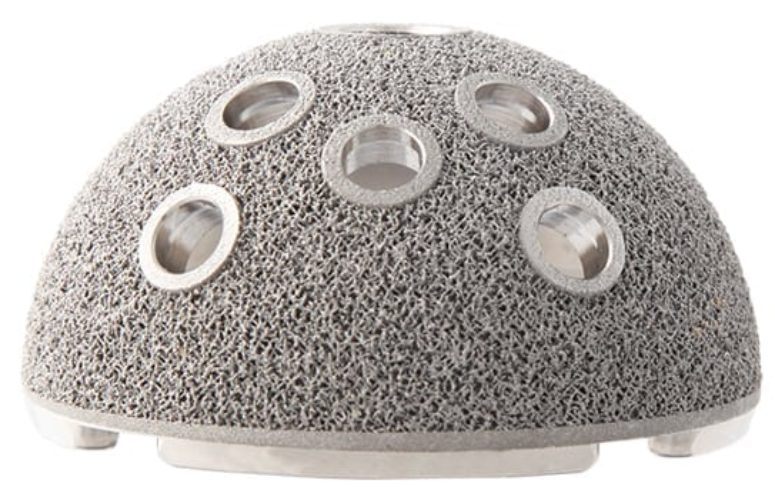
Cutting-Edge Hospital and Medical Technology
The state’s healthcare systems and medical technology firms are embracing high-tech innovations to benefit patients and providers alike.
By Jennifer Lesser, Contributing Writer On Jun 25, 2018The Garden State’s healthcare systems and medical technology firms continue to implement the latest and greatest in medical innovations. From more precise surgical methods to offering patients new ways to keep track of their health, today’s advancements in medical technology are making a significant impact on the healthcare industry in New Jersey.
“Our strategy is to provide high-quality care and an optimal patient experience in the right place and time. Advances in technology help us to honor this mission to create the best care that’s also convenient and affordable … and help patients heal faster and minimize risk,” asserts John K. Lloyd, co-CEO of Hackensack Meridian Health. As an example, the hospital has a Medicare accountable care organization (ACO) that’s now ranked third in the nation because of an exceptional quality score of 92 and savings of $50.5 million.
“By embracing so many advances in technology, we’re better able to track patients and troubleshoot quickly so that minor problems don’t become big ones. In just two years, this highly advanced and coordinated care resulted in a huge decrease in unnecessary care: ER visits decreased 33 percent, hospital readmissions were reduced by 47 percent, and days in skilled nursing facilities dropped nearly 40 percent,” he adds. “The bottom line is everyone wins and we’re expanding these high quality scores and savings throughout our network.”
Hackensack Meridian is one of the first healthcare networks in the state to offer robotic-assisted minimally invasive coronary artery bypass graft surgery (CABG), which results in better outcomes and reduces the traumatic impact and recovery process for patients. “[The technology] helps surgeons not only better visualize malignancies and other problems, but allows them to have a better read on healthy tissue to preserve maximum functionality,” explains Robert C. Garrett, co-CEO of Hackensack Meridian Health. “It also aids surgeons in explaining the surgery to patients who can wear 3D glasses and see a giant scan of their brain – it’s like an expedition into the human brain.”
Many of the state’s healthcare networks are implementing new innovations in cutting-edge modalities like robotics to help enhance the precision of surgeries for the treatment of cancer. Englewood Hospital and Medical Center (EHMC) offers the latest robotic technology to aid in treatments of diseases of the gastrointestinal tract, female reproductive organs as well as lung and urologic conditions. Robotic technology allows surgeons to perform surgery through tiny incisions that reduce or eliminate the trauma of open surgeries and the risk of damaging healthy tissue.
“There are nearly 15 million Americans who are either living with cancer or who are survivors of cancer – and that’s a direct result of the incredible technologies that are now available for diagnosis and treatment,” says Dr. Steven Brower, medical director of the Lefcourt Family Cancer Treatment and Wellness Center at EHMC.
Notably, EHMC has made strides in its radiation oncology capabilities. Surgeons are utilizing technology that can precisely treat tumors even on a moving target like the lung. “One challenge we’ve always had in treating tumors of the lung is that it moves when you breath, but we now have technology that will activate a beam only when the target is in the correct position to save healthy tissue and ensure we’re only targeting the tumor,” explains Dr. Michael Speiser, medical physicist in the department of radiation oncology at EHMC.
The hospital also utilizes a Calypso system – a monitor that’s about the size of a grain of rice and can be implanted directly at or near a tumor – in prostate and lung treatments. “It’s sort of like a GPS for your body, so we can get this submillimeter, continuous monitoring of the target,” Speiser adds. “It takes about 20 minutes to deliver the treatment, there’s no hospitalization, and the patient goes home that day.”
Robert Wood Johnson Barnabas Health (RWJBH) has implemented proton therapy as another precise and advanced form of radiation treatment that primarily radiates the tumor site, leaving surrounding healthy tissue and organs intact.
“Conventional X-ray radiation often radiates healthy tissue in its path and surrounding the tumor site, and chemotherapy moves throughout the entire body,” explains Dr. Rahul R. Parikh, medical director of the Laurie Proton Therapy Center at Robert Wood Johnson University Hospital (RWJUH) and radiation oncologist at Rutgers Cancer Institute of New Jersey. The MEVION S250 is providing RWJUH with a compact, high-quality delivery system to include in its suite of patient treatment options.
The Radiation Oncology Department at Saint Barnabas Medical Center was the first hospital in the area to utilize the SpaceOAR System for patients receiving radiation therapy for prostate cancer. The SpaceOAR System is a temporary hydrogel spacer that’s injected between the rectum and the prostate to increase the area between the two structures. “While radiation treatment has become significantly more targeted, one of the biggest risks of radiation therapy of the prostate is injury to the rectum due to its close proximity to the prostate,” explains Alison Grann, MD, chair of the department of radiation oncology at Saint Barnabas Medical Center.
The hospital is also treating patients with the most cutting-edge radiation delivery technology, including CyberKnife, a robotic radiosurgery system that uses advanced computer guidance software to target cancerous lesions with laser-like precision. CyberKnife delivers high-dose beams of radiation with extreme accuracy to hard-to-reach tumors anywhere in the body. Additionally, it can treat prostate cancer in just five treatments instead of the traditional 40 to 45 treatments over the course of eight weeks.
At Valley Hospital, the latest cancer technology is allowing surgeons to treat malignant and benign tumors and neurological conditions in the brain with accuracy that was never before possible. The Gamma Knife Icon is a non-invasive, radiosurgical technology that enables the hospital’s team to treat virtually any location in the brain with the highest level of precision and without damage to surrounding brain tissue.
“Valley-Mount Sinai Comprehensive Cancer Care (VMSCCC) is passionate about providing our community, our patients and their families the highest quality cancer care,” says Dr. Ephraim Casper, chief medical officer of VMSCCC. “That mission relies, in part, on developing and implementing precision medical technology with sound judgment, clinical skill and compassion.”
Technological advancements are also extending beyond the treatment of cancer, such as innovations in newborn and maternity care. Angel Eyes, an internet-based camera system, allows parents and families to see and interact with their babies who are in the neonatal intensive care unit (NICU) via live video streaming and direct, one-way audio.
It was established in 2013 and introduced at Monmouth Medical Center in March of 2018 – the first hospital in New Jersey to debut the system. “This technology helps provide peace of mind to parents and promotes bonding between parents and their premature babies, who sometimes have to stay in the hospital for weeks or months,” explains Susan Hudome, MD, chief of neonatology and medical director of the Hirair and Anna Hovnanian Foundation Regional Newborn Center at Monmouth Medical Center. “The far-reaching ability of the system also allows for babies to hear the voices of family members worldwide.”
At AtlantiCare, an Intelligent Retinal Imaging Systems (IRIS) machine is helping to ensure that patients with diabetes are not losing their eyesight due to diabetic retinopathy, which occurs when high blood sugar levels damage blood vessels in the retina. The scanner takes a picture of the patient’s eyes, saves it to the cloud and enhances it with artificial intelligence (AI) so that the image can be reviewed by a board certified ophthalmologist within 24 hours. “Prior to offering this technology, we learned that the vast majority of diabetic patients were not getting routine ophthalmologic evaluations, which is unacceptable,” asserts Dr. Paul Ehrlich, chief medical information officer for AtlantiCare. “We’ve been offering this technology for only a few months, and have already diagnosed about 20 percent of patients with some degree of a vision issue – and half of those actually have diabetic retinopathy – and with early intervention, we can prevent blindness.”
Meanwhile, at Saint Peter’s Healthcare System, SeamlessMD’s patient engagement and quality improvement platform is now being scaled across the enterprise as a standard of care for patients undergoing caesarean sections and total joint replacement (Saint Peter’s first implemented SeamlessMD for its caesarean section patients in November 2016).
Patients using SeamlessMD are engaged before and after surgery via smartphone, tablet and computer. The overall program includes reminders, tasks, tailored education and daily milestone tracking to help patients follow Enhanced Recovery After Surgery (ERAS), a proven model for accelerating recovery. Based on what patients record throughout their journey, they receive automated feedback on how to self-manage common concerns. Providers are also able to monitor patients remotely using a real-time dashboard, allowing patients to stay connected with the care team, particularly at home after leaving the hospital.
Over the past year, Saint Peter’s has used SeamlessMD to reduce hospital length of stay by 1.5 days, allowing patients to go home sooner and producing significant cost savings for the health system.
Attila Kett, MD, chair of Anesthesia at Saint Peter’s and champion for the initiative, says: “The biggest challenge that SeamlessMD helped us solve is how to educate our patients. It is clearly extremely important that patients know the benefits of this program and become empowered so they can make their own decisions. With SeamlessMD, our length of stay is dropping – even exceeding our optimistic predictions – because our patients now feel safe despite going home earlier, as they have the knowledge that we’re able to monitor their recovery remotely and intervene should there be a problem.”
The state’s hospitals aren’t the only organizations that are investing in the latest and greatest technology. Medical technology firms are also doing their part to release the most cutting-edge products to benefit New Jersey’s patients and providers, such as new digital health initiatives. Novo Nordisk, for example, has turned its sights towards diabetes. The company recently launched the Cornerstones4Care Powered by Glooko disease management app. The free diabetes management app helps track a patient’s blood sugar, activity, meals and medicines all in one place.
“Digital health is rapidly transforming all aspects of the healthcare ecosystem by creating new opportunities to improve care, one of the most pressing areas for research and development is patient self-management. People living with chronic disease require better, more personalized support tools to help address the often overwhelming task of managing a disease,” asserts Amy West, senior director of patient centric marketing for Novo Nordisk US.
Other medical technology firms are working on further enhancing the surgical technologies that are helping healthcare providers perform surgeries like they never could before. Stryker recently introduced Mako, a robotic-arm assisted technology that helps surgeons provide patients with a personalized surgical experience via a 3D model of the hip or knee that’s used to pre-plan and assist surgeons in performing joint replacement surgery. “Previously, a surgeon would use a 2D picture and, during the operation, would only have mechanical sizing equipment to use as a gauge. With Mako, they have a 3D image and can plan the operation down to the size of the components they’ll need – and assess the patient’s soft tissue, balance and joint function – before the surgery even begins,” explains Stuart Simpson, president of Stryker’s joint replacement division. The robotic arm helps guide the surgeon with a degree of precision that wasn’t possible without this technology, and at the end of the day, each patient is getting an individualized surgery that’s right for them.”
Meanwhile, medical technology firms like Roche Diagnostics are investing in innovations that allow for faster, more accurate testing and diagnoses. The company’s molecular diagnostic manufacturing site location in Branchburg recently launched a new Liat product, a compact, innovative real-time PCR platform designed to test for strep, flu and RSV at the point of care. The test provides 99 percent accurate results in just 20 minutes; the company was also recently tapped to develop a blood test for the Zika virus. “Our goal is always to develop products with the highest level of accuracy and that focus on key questions that patients have … so not only can these tests tell them within minutes whether they have the disease, but we can also determine which therapies they’ll need and whether they’ll be effective for that individual patient,” explains Nicholas M. Solimo, vice president of Roche Diagnostics Global Operations.
As technological capabilities continue to emerge, hospitals and medical technology companies will have to continue to pick and choose which emerging innovations to invest in. “We can’t fall victim to ‘shiny toy syndrome’ and chase every new technology before it’s fully vetted or without considering whether it fulfills our organization’s objectives,” Ehrlich says. He notes that Atlanticare routinely goes through strategic planning processes to identify which innovations are best serving the patient population.
Garrett notes that Hackensack Meridian Health is constantly scanning for the latest technology to invest in. “Before companies reach our panel of experts, we have an ideation process where we explore the latest proposals to see if it meets a need we have, if it’s a good business strategy, and if it’s scalable,” he explains. This process takes place at the New Jersey Innovation Institute, affiliated with NJIT in Newark, but the hospital also collaborates with other innovative partners.
“At Stryker, we do have heavy investment in research and development, and we do invest a lot of our capital in acquiring new companies, but we also have to have an agenda for innovation and a robust process for prioritizing and identifying our internal investment activities,” Simpson concludes. “We’re excited about where we are in our journey, and look forward to many years of continued innovation.”
Related Articles:






